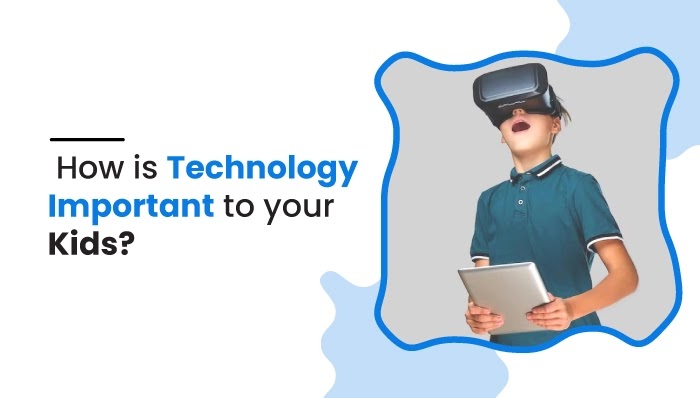
How is Technology Important to Your Kids?
In the current digital era, technology has impacted every aspect of our lives, including our children’s. Kids are now being exposed to technology at a younger age, which has pros and cons. While some might find using technology for kids concerning, it’s vital to acknowledge its benefits for our children if utilized moderately and with adult supervision.
So how is technology important to kids?
For youngsters, technology has created a world of opportunities for learning and development. Thanks to technological advancements, children now have access to various knowledgeable and educational content.
However, considering all its negative effects, you might still not be convinced enough to give your kids access to technology.
So this article will dive into detail about how technology is important to your kids while highlighting its potential concerns so that it will be easier for you to decide what steps to take for your kids’ benefit.
Benefits of Technology for Children

Technology has become a substantial need in today’s modern generation, especially for kids. Children with access to technology are more likely to perform well in their lives, be it academically, socially, or in any other aspects.
So what are the benefits of technology for children? Let’s find out!
The likelihood that your child will meet other children to engage and bond on online platforms outweighs the likelihood that they will meet children who don’t use or enjoy technology.
Like sports, reading, and other activities, social media, video games, and mobile apps are all hobbies and interests that might help strengthen social interactions by two folds. Along with this,
- Kids can learn new language skills and how to collaborate and communicate more effectively through the Internet’s social relationships.
- Technology fosters closer relationships between students and parents. Games and group activities can be carried out in the classroom using a single piece of technology to promote group collaboration.
- Teachers can include parents in their class activities using video and audio files to capture and share their students’ work. This promotes open communication and engagement among parents and kids.
- Additionally, kids can increase their social interactions and skills by getting to know individuals in different languages and cultures with the help of the internet and technology.
Kids have the potential to achieve great things but imagine their potential once they have the reach to greater knowledge, resources, and essential materials. And how do they get access to these greater resources? Technology!
- Research tasks can now be completed without setting foot inside a real library due to the abundance of informational resources on the Internet, particularly online libraries.
- Early education is now much more accessible as the internet and technology have made access to books and reliable knowledge much easier, preventing kids from being too dependent on elders from an early age.
Kids are curious and always seeking answers, so you may imagine the difference between a kid who can easily get the answers to their queries instantly and the one who has to wait for a guardian or teacher until the next day or days later for answers.
When children can come up with solutions to problems, it might motivate them to conduct additional research and follow their train of thought independently. Through this process, children’s interests in new activities might grow with their independence and academic confidence.
While using technology, children are frequently presented with challenges that teach them how to solve such problems and make decisions.
Similarly, modern video games are improving, and overcoming some challenges in those games requires a commendable degree of mental skill. As a result, games and apps can help kids gain the experience they need to succeed in the future.
Take the game Minecraft’s survival mode, for example.
- In the game, players are thrown into unfamiliar locations, and their only chance of survival is to construct shelters and gather supplies like food and weapons quickly. Thus, games like these teach kids to act quickly and independently to succeed in whatever they put their minds to.
Additionally, technology allows for greater freedom of expression, allowing children to create goals and accomplish them mainly on their own. They encounter obstacles and difficulties along the way, which they must overcome to achieve their objectives, and over time they develop the skills necessary to overcome them.
Kids are imaginative and are always willing to express themselves in the most creative forms.
While kids in the past only had access to papers and art supplies to get out their creative ideas, the kids in this technological era have access to digital art tools where they can play with various colors, forms, and textures.
So, in addition to a traditional sketch, they can create digital art or 3D animation, for example. Other benefits of the technology include:
- Technology today provides kids access to a wide range of creative inspiration. For instance, YouTube and other video-sharing sites are full of tutorials, how-to videos, and other materials that might assist kids in picking up new skills and methods.
- It enriches children’s learning experiences and creativity by allowing them to learn new skills in a fun and interesting way using educational games and applications.
Thus, technology can be a potent tool for boosting creativity in children.
In the past, when there was no technology, the primary forms of learning and gaining knowledge were only through schools, libraries, and physical books. Students had to walk miles to learn about something or wait for a long time to get answers to their questions. This scenario has completely changed with the advancement of technology.
Technology today has become a powerful teacher for kids from an early stage.
Stuck on a maths problem? Kids can now quickly search for it on the internet and solve it without waiting another day to ask their teacher.
- Even in schools, traditional classrooms have transformed into digital classrooms.
- Students and teachers can use digital resources like projectors to watch subject-related documentaries and present their Powerpoint slides and projects.
- Physical books have become optional for students, making the learning process smooth and convenient, enhancing the learning process.
- Children now have access to various information that can be used to research practically any topic.
This can help children broaden their knowledge base and learn about topics that might not be included in their schoolwork.
Potential Concerns and How to Address Them
With the advancement of technology, it’s more common than ever for kids to be exposed to numerous types of technology at a young age. While technology can be a great learning tool for kids, parents, and childhood educators might be worried about how it might have negative effects on their children’s development.
Here are some of the common potential concerns of parents and childhood educators regarding the use of technology by kids.
- Excessive Screen Time: When kids get immersed in technology and social media, they spend more time on screen than engaging in physical activity, interacting with others in person, or learning new skills. And too much time spent on screen can cause attention difficulties, eyesight problems, sleeping issues, and other health problems.
- Online Dangers: Children may encounter unsuitable content or connect with strangers online. Thus, with the rise in the issues of cyberbullying, harassment, identity theft, etc., parents and childhood educators are becoming increasingly concerned about their kids’ safety online.
- Addiction: Kids might sometimes get so immersed in technology leading to addiction, that they will forget they have a life outside of the virtual world. They have problems staying without technology and might show behavioral issues when they do not get to use it as they desire.
So what can we do to minimize the cons of using technology for kids? Here are some strategies to address the issues.
- Limit screen time according to the child’s age and create screen-free zones or periods at home.
- Encourage sports, physical, and other outside activities.
- Give children a chance to express their creativity through drawing, painting, or building with blocks.
- Teach kids the importance of maintaining their privacy and safety online, including reporting improper or bullying behavior, avoiding unsafe websites and apps, and not sharing personal information.
- Use parental controls and monitoring programs to restrict access to unsuitable content and keep tabs on online activities.
All in all, it’s crucial to encourage responsible digital citizenship and online safety among kids and have open, ongoing conversations with them about how they use technology. Encourage kids to discuss their technology-related questions, worries, and experiences while offering advice and assistance to help them navigate the online world.
Tips For Choosing Appropriate Technology for Children
Everything has its pros and cons, and many people still debate regarding the use of technology for kids. By now, we have looked at the range of benefits and potential concerns regarding technology for kids.
So to clear the concerns and address the issues, choosing the appropriate technology for children is crucial.
Thus, here are some tips for choosing the appropriate technology for children.
While choosing technology, parents must be intentional about when and what kind of technology to provide their kids. Age-appropriate technology should be used according to the kids’ developmental needs.
For example, if your kid is a toddler, interactive apps that improve basic skills like counting and language development are appropriate. At the same time, older children may enjoy educational games focusing on science, math, and critical thinking.
Choose technology that focuses on kids’ online safety and privacy. Likewise, kids’ applications with built-in safety features, such as parental controls and content filters, will help ensure your child is not viewing inappropriate content or engaging in unsafe online interactions.
Parents should encourage kids to use technology to learn new skills and creativity with educational value. Help your children choose the right learning platform, which can significantly improve their academics, creativity, and imagination.
Integrating Technology into Learning and Play
Integrating technology into learning and play can benefit overall kids’ development. Here are some examples of how technology can be used in various elements of kids’ lives:
- Interactive whiteboards: Interactive whiteboards can be an excellent teaching tool that encourages students to be attentive and participate more in class. For instance, multimedia materials like films and animations can attract students to the subject matter more and encourage direct interaction with the lesson material.
- Educational technology and apps: Different educational technology assist students in learning new concepts in a pleasant and engaging manner. There are apps that provide a variety of features like quizzes, games, and interactive courses to make studying enjoyable and exciting. For example, educational apps like Khan Academy and Duolingo assist kids with their course studies and help them learn new languages.
- Virtual learning tools: Many virtual learning tools exist today that make it easier for students to communicate with teachers and tutors worldwide. Apps like Zoom and Skype also provide interactive tools like screen sharing, virtual whiteboards, and chat options to make learning more engaging.
- Apps for digital storytelling: With the help of technology, kids can broaden their creative horizons and improve their skills. For example, an app like Make Beliefs Comix, 30hands, etc., allows children to create digital storytelling, which helps to enrich their creativity.
- Gaming apps: Using technology, kids can now play educational games that assist in improving their collaboration, teamwork, time-management, and problem-solving skills.
Conclusion
To sum up, technology, if used in moderation and under parents’ supervision, kids can reap numerous benefits, such as learning enhancement, enhancing creativity, and promoting social interaction.
However, parents should be mindful of the potential risks and learn how to address them timely while teaching kids about digital literacy and how to use technology responsibly and age-appropriately.
Remember that it is important to strike a balance between technology and your life outside of it. Thus, encourage your kids to use technology to explore their interests and passions without neglecting other activities like outdoor play, reading, and social interaction.






